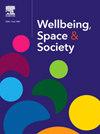Do green and blue spaces in the residential neighbourhood have an effect on multimorbidity? A comparative, observational study of 48,589 UK Biobank participants
IF 2.2
Q2 GEOGRAPHY
引用次数: 0
Abstract
Introduction
Availability of green and blue space in the urban residential neighbourhood can reduce the risk of poor mental and physical health, however, little is still known about different types of urban green and blue spaces and their differential impact on individuals that have multiple physical and mental chronic health conditions.
Methods
We conducted a cross-sectional study of 48,589 UK Biobank participants to analyse the relationship between exposure to seven types of urban green and blue spaces (parks, street trees, domestic gardens, total green space, inland blue space, proximity to coast and total green and blue space) with five multimorbidity outcomes: simple (2 long-term health conditions (LTCs)), complex (3 LTCs or 4+LTCs), cardio-metabolic, respiratory, and mental multimorbidity. Amount (% in 1500 m circular buffers) and proximity (Euclidean distance) of green and blue spaces in the residential neighbourhood were computed individually for each UK Biobank participant using remote sense data from European Urban Atlas. Analyses were adjusted for the Bonferroni correction for multiple testing to reduce the risk of false positive results. Sensitivity analyses were conducted by buffer size (300 m and 3000 m).
Findings
Individuals that have a higher proportion of inland blue spaces in their residential neighbourhood had lower odds of multimorbidity. For every percent increase in the amount of inland blue space in 3000 m buffer, the odds of having complex multimorbidity (3LTCs) decreased by 3 % (OR:0·97; 95 % CI:0·95–0·98; p-value:0·0002) after applying the Bonferroni correction. In contrast, individuals with a higher amount of total green space within a 1500 m buffer had a higher risk of having 4+ LTCs (OR:1·01; 95 % CI:1·00–1·01; p-value:0.00005). Other types of green and blue spaces had no effect on our outcomes.
Conclusion
Urban inland blue spaces, such as rivers and canals, are integral parts of life in UK but they have often been overlooked in observational health research. Future policy should aim to incorporate blue spaces in the design of urban regeneration and public health interventions.
居民区的绿色和蓝色空间对多重疾病有影响吗?一项对48,589名英国生物银行参与者的比较观察性研究
城市居民区的绿色和蓝色空间的可用性可以降低精神和身体健康状况不佳的风险,然而,人们对不同类型的城市绿色和蓝色空间及其对患有多种身心慢性健康状况的个体的不同影响知之甚少。方法我们对48,589名英国生物银行参与者进行了一项横断面研究,分析暴露于七种类型的城市绿色和蓝色空间(公园,街道树木,家庭花园,总绿地,内陆蓝色空间,靠近海岸和总绿色和蓝色空间)与五种多重疾病的关系:简单(2种长期健康状况(LTCs)),复杂(3种或4+LTCs),心脏代谢,呼吸和精神多重疾病。使用来自欧洲城市地图集的遥感数据,为每个英国生物银行参与者单独计算居民区绿色和蓝色空间的数量(在1500米圆形缓冲区中的百分比)和接近度(欧几里得距离)。对分析进行Bonferroni校正,以减少假阳性结果的风险。根据缓冲区大小(300米和3000米)进行敏感性分析,发现居住区内内陆蓝色空间比例较高的个体患多重疾病的几率较低。在3000 m缓冲区内,内陆蓝色空间每增加1%,复杂多病(3LTCs)的几率降低3% (OR: 0.97;95% ci: 0.95 - 0.98;p值:0.0002),经Bonferroni校正。相比之下,在1500 m缓冲区内绿地面积较大的个体发生4+ LTCs的风险较高(OR:1·01;95% ci: 1.00 - 1.01;假定值:0.00005)。其他类型的绿色和蓝色空间对我们的结果没有影响。结论城市内陆蓝色空间,如河流和运河,是英国人生活中不可或缺的一部分,但在观察性健康研究中往往被忽视。未来的政策应旨在将蓝色空间纳入城市更新和公共卫生干预措施的设计中。
本文章由计算机程序翻译,如有差异,请以英文原文为准。
求助全文
约1分钟内获得全文
求助全文
来源期刊

Wellbeing Space and Society
Social Sciences-Social Sciences (miscellaneous)
CiteScore
2.70
自引率
0.00%
发文量
46
审稿时长
124 days
 求助内容:
求助内容: 应助结果提醒方式:
应助结果提醒方式:


